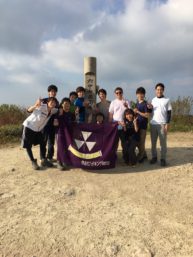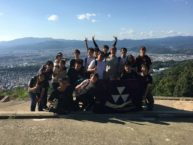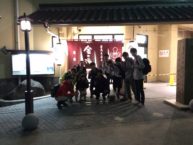For my CIP, I decided to join Doshisha University’s Light Music Club – an umbrella, music organization which contains over 70 musical ensembles. The whole premise of the club is that students who enjoy playing music with others can do so freely. This means that students often create their own bands, schedule performances, and invite other members of the club to watch those live performances, etc… The Light Music Club has 3 main practice spaces, and you can find the main practice space filled with people at any time of day. Because I have played trumpet and piano for a majority of my life, and since I am a part of the jazz orchestra at my university, I figured that I should join a music organization on campus. Currently, I am a member of 8 different music ensembles in the club! Since music has played such an integral role in my life, I felt like I could share my passion and knowledge of the subject by interacting and performing with other members of the club.
Every year, Doshisha University hosts its own festival called “Eve Festival”, which is a 3-day long event filled with food, games, and performances. In preparation for our bands’ live performances, I have gone to many rehearsals (almost 3 to 4 every week). There have even been rehearsals that run until 2:00 AM! Therefore, I am around many members of the organization for many hours. This presents many opportunities to interact with other students in Japanese, however, there have also been challenges in communication that I have encountered.
Because the organization has over 120 members, there are well-established cliques of students within the club, and therefore not everybody is interested in talking to new students – let alone students who do not speak the native language. In the beginning, I found myself not being able to understand what the other members were saying to each other in fast, Kansai dialect. However, over spending hours with some of the members inside and outside of rehearsal, I have been able to develop deeper relationships with a few of the them. It is still not easy to participate in larger group settings, as there is quick banter that goes back-and-forth, but I have found that people are much easier to talk to when you talk to them one-on-one. Since a lot of the band members like to congregate in the main practice space, this has been a very good place to try and talk to new people.
There are many ways in which I have initiated communication, or have interacted with members of the organization. For example, after jamming with the members in the main practice space, a number of them invited me to join the bands they were making for Eve Festival, and this is how I became a part of 8 different musical ensembles. This gave me the opportunity to interact with the band members before, during, and after rehearsals, and I have hung out with them outside of rehearsals on several occasions – whether it was going out to eat, or playing Super Smash Bros. Also, in order to schedule rehearsals and work out logistics, we often have to communicate with each other through LINE – a popular messaging service used in Japan. Using LINE has helped immensely by clearing up misunderstandings I may have had during rehearsal, and it has also been a useful tool in getting to know people who would otherwise be shy talking to me in person.
By spending time in the Light Music Club, I noticed a few cultural differences between my experiences playing with musical ensembles in America and Kyoto. The structure of jazz education taught in schools, operations and demography of collegiate music clubs, and 検便 (kenben) all came as forms of culture shock to me. Having grown up in Las Vegas, I was used to most public high schools having marching, jazz, and concert band programs. However, after talking to a lot of the members in the club about their musical experiences, jazz and marching programs in public schools are not very common, and music is regarded more as a club activity – not as a class. This system seems to continue through college, as Doshisha University does not have a music program, and all music organizations are student-run. The fact that all rehearsals are scheduled, organized, and conducted by students surprised me, and I was also surprised by the number of women who participated in these musical ensembles. There has been a lot of criticism directed towards the American jazz community because of sexism and lack of female participation in many bands, and I have definitely noticed this trend in my high school and college experiences. However, the Doshisha Light Music Club has an even-split of men and women who perform in their bands. The most “unique” experience I had was having to do “kenben” – or fecal examination. Yeah… I don’t think I need to explain why this came as a surprise. This isn’t common, though, so don’t let it discourage you from joining a circle!
My biggest piece of advice for those interested in joining a circle is that you should be proactive in trying to forge relationships. This is due to a number of factors: 1) Many of the members already know each other, and won’t inherently have an interest to make more friends. 2) People might assume you are busy if you keep to yourself and are silent. 3) Others are just as afraid of the language-barrier as you are.
Although there have been some challenges in communication, joining the club has been a rewarding experience overall! I would recommend this club to those who interested in music, and are willing to be proactively involved in Doshisha’s community!



